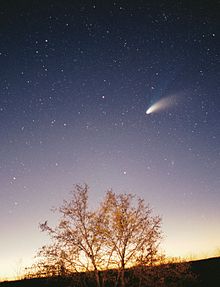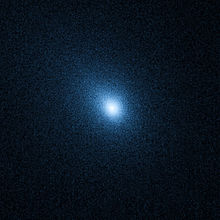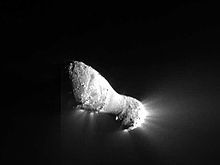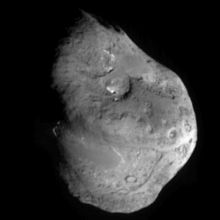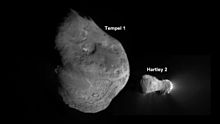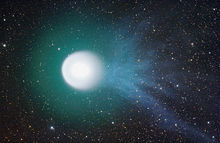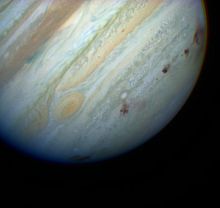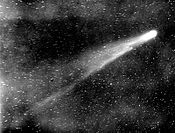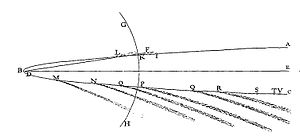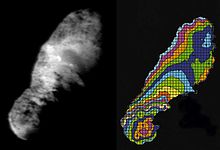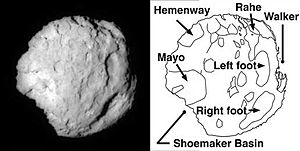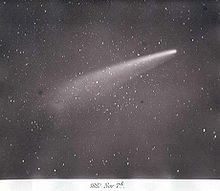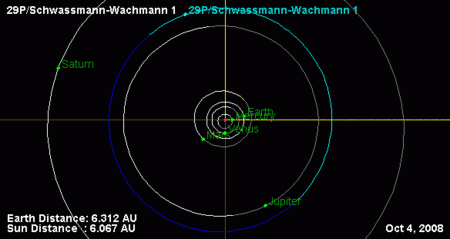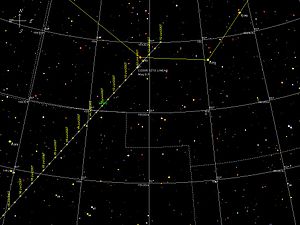- Comet
-
A comet is an icy small Solar System body that, when close enough to the Sun, displays a visible coma (a thin, fuzzy, temporary atmosphere) and sometimes also a tail. These phenomena are both due to the effects of solar radiation and the solar wind upon the nucleus of the comet. Comet nuclei range from a few hundred meters to tens of kilometers across and are composed of loose collections of ice, dust, and small rocky particles. Comets have been observed since ancient times and have traditionally been considered bad omens.
Comets have a wide range of orbital periods, ranging from a few years to hundreds of thousands of years. Short-period comets originate in the Kuiper belt, or its associated scattered disc,[1] which lie beyond the orbit of Neptune. Longer-period comets are thought to originate in the Oort cloud, a spherical cloud of icy bodies in the outer Solar System. Long-period comets plunge towards the Sun from the Oort cloud because of gravitational perturbations caused by either the massive outer planets of the Solar System (Jupiter, Saturn, Uranus, and Neptune), or passing stars. Rare hyperbolic comets pass once through the inner Solar System before being thrown out into interstellar space along hyperbolic trajectories.
Comets are distinguished from asteroids by the presence of a coma or a tail. However, extinct comets that have passed close to the Sun many times have lost nearly all of their volatile ices and dust and may come to resemble small asteroids.[2] Asteroids are thought to have a different origin from comets, having formed inside the orbit of Jupiter rather than in the outer Solar System.[3][4] The discovery of main-belt comets and active centaurs has blurred the distinction between asteroids and comets (see asteroid terminology).
As of January 2011[update] there are a reported 4,185 known comets[5] of which about 1,500 are Kreutz Sungrazers and about 484 are short-period.[6] This number is steadily increasing. However, this represents only a tiny fraction of the total potential comet population: the reservoir of comet-like bodies in the outer Solar System may number one trillion.[7] The number visible to the naked eye averages roughly one per year, though many of these are faint and unspectacular.[8] Particularly bright or notable examples are called "Great Comets".
Contents
Etymology
The word comet derives from the Latin word cometes, which is the latinisation of the Greek κομήτης (komētēs), meaning "comet", but literally "long-haired",[9] from the word κόμη (komē), which means "hair of the head".[10] The Greek scientist and philosopher Aristotle first used the derived form of κόμη, κομήτης, to describe what he saw as "stars with hair." The astronomical symbol for comets is (☄), consisting of a small disc with three hairlike extensions.
Physical characteristics
Nucleus
Comet nuclei are known to range from about 100 meters to more than 40 kilometres across. They are composed of rock, dust, water ice, and frozen gases such as carbon monoxide, carbon dioxide, methane and ammonia.[11] Because of their low mass, comet nuclei do not become spherical under their own gravity, and thus have irregular shapes.
They are often popularly described as "dirty snowballs", though recent observations have revealed dry dusty or rocky surfaces, suggesting that the ices are hidden beneath the crust. Comets also contain a variety of organic compounds; in addition to the gases already mentioned, these may include methanol, hydrogen cyanide, formaldehyde, ethanol and ethane, and perhaps more complex molecules such as long-chain hydrocarbons and amino acids.[12][13][14] In 2009, it was confirmed that the amino acid glycine had been found in the comet dust recovered by NASA's Stardust mission.[15] In August 2011, a report, based on NASA studies with meteorites found on Earth, was published suggesting DNA and RNA components (adenine, guanine and related organic molecules) may have been formed on asteroids and comets in outer space.[16][17][18]
Surprisingly, cometary nuclei are among the least reflective objects found in the Solar System. The Giotto space probe found that the nucleus of Halley's Comet reflects about four percent of the light that falls on it,[19] and Deep Space 1 discovered that Comet Borrelly's surface reflects just 2.4% to 3.0% of the light that falls on it;[19] by comparison, asphalt reflects seven percent of the light that falls on it. It is thought that complex organic compounds are the dark surface material. Solar heating drives off volatile compounds leaving behind heavy long-chain organics[clarification needed] that tend to be very dark, like tar or crude oil. The very darkness of cometary surfaces enables them to absorb the heat necessary to drive their outgassing processes.
Coma and tail
In the outer Solar System, comets remain frozen and are extremely difficult or impossible to detect from Earth due to their small size. Statistical detections of inactive comet nuclei in the Kuiper belt have been reported from the Hubble Space Telescope observations,[20][21] but these detections have been questioned,[22][23] and have not yet been independently confirmed. As a comet approaches the inner Solar System, solar radiation causes the volatile materials within the comet to vaporize and stream out of the nucleus, carrying dust away with them. The streams of dust and gas thus released form a huge, extremely tenuous atmosphere around the comet called the coma, and the force exerted on the coma by the Sun's radiation pressure and solar wind cause an enormous tail to form, which points away from the sun.
Both the coma and tail are illuminated by the Sun and may become visible from Earth when a comet passes through the inner Solar System, the dust reflecting sunlight directly and the gases glowing from ionisation. Most comets are too faint to be visible without the aid of a telescope, but a few each decade become bright enough to be visible to the naked eye. Occasionally a comet may experience a huge and sudden outburst of gas and dust, during which the size of the coma temporarily greatly increases. This happened in 2007 to Comet Holmes.[24]
The streams of dust and gas each form their own distinct tail, pointing in slightly different directions. The tail of dust is left behind in the comet's orbit in such a manner that it often forms a curved[citation needed] tail called the type II or dust tail. At the same time, the ion or type I tail, made of gases, always points directly away from the Sun, as this gas is more strongly affected by the solar wind than is dust, following magnetic field lines rather than an orbital trajectory. On occasions a short tail pointing in the opposite direction to the ion and dust tails may be seen – the antitail. These were once thought to be somewhat mysterious, but are merely the end of the dust tail apparently projecting ahead of the comet due to our viewing angle.[25]
While the solid nucleus of comets is generally less than 50 km (31 mi) across, the coma may be larger than the Sun, and ion tails have been observed to extend one astronomical unit (150 million km) or more.[11] The observation of antitails contributed significantly to the discovery of solar wind.[26] The ion tail is formed as a result of the photoelectric effect[dubious ] of solar ultra-violet radiation acting on particles in the coma. Once the particles have been ionized, they attain a net positive electrical charge which in turn gives rise to an "induced magnetosphere" around the comet. The comet and its induced magnetic field form an obstacle to outward flowing solar wind particles. As the relative orbital speed of the comet and the solar wind is supersonic, a bow shock is formed upstream of the comet, in the flow direction of the solar wind. In this bow shock, large concentrations of cometary ions (called "pick-up ions") congregate and act to "load" the solar magnetic field with plasma, such that the field lines "drape" around the comet forming the ion tail.[27]
Encke's Comet loses its tail
If the ion tail loading is sufficient, then the magnetic field lines are squeezed together to the point where, at some distance along the ion tail, magnetic reconnection occurs. This leads to a "tail disconnection event".[27] This has been observed on a number of occasions, one notable event being recorded on April 20, 2007, when the ion tail of Encke's Comet was completely severed while the comet passed through a coronal mass ejection. This event was observed by the STEREO space probe.[28]
Comets were found to emit X-rays in 1996.[29] This greatly surprised astronomers, because X-ray emission is usually associated with very high-temperature bodies. The X-rays are generated by the interaction between comets and the solar wind: when highly charged solar wind ions fly through a cometary atmosphere, they collide with cometary atoms and molecules, "stealing" one or more electrons from the atom in a process called "charge exchange". This exchange or transfer of an electron to the solar wind ion is followed by its de-excitation into the ground state of the ion, leading to the emission of X-rays and far ultraviolet photons.[30]
Connection to meteor showers
As a result of outgassing, comets leave a trail of solid debris. If the comet's path crosses Earth's path, then at that point there are likely to be meteor showers as Earth passes through the trail of debris. The Perseid meteor shower occurs every year between August 9 and August 13, when Earth passes through the orbit of Comet Swift–Tuttle.[31] Halley's comet is the source of the Orionid shower in October.[31]
Orbital characteristics
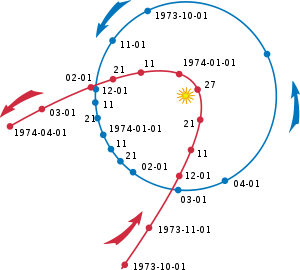 Orbits of the Kohoutek Comet (red) and the Earth (blue), illustrating the high eccentricity of its orbit and its rapid motion when close to the Sun.
Orbits of the Kohoutek Comet (red) and the Earth (blue), illustrating the high eccentricity of its orbit and its rapid motion when close to the Sun.
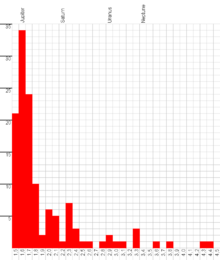 Histogram of the aphelia of the 2005 comets, showing the giant planet comet families. The abscissa is the natural logarithm of the aphelion expressed in AUs.
Histogram of the aphelia of the 2005 comets, showing the giant planet comet families. The abscissa is the natural logarithm of the aphelion expressed in AUs.
Most comets have elongated elliptical orbits that take them close to the Sun for a part of their orbit, and then out into the further reaches of the Solar System for the remainder. Comets are often classified according to the length of their orbital periods: the longer the period the more elongated the ellipse.
- Short-period comets are generally defined as having orbital periods of less than 200 years. They usually orbit more-or-less in the ecliptic plane in the same direction as the planets. Their orbits typically take them out to the region of the outer planets (Jupiter and beyond) at aphelion; for example, the aphelion of Halley's Comet is a little beyond the orbit of Neptune. At the shorter extreme, Encke's Comet has an orbit which never puts it farther away from the Sun than Jupiter. Short-period comets are further divided into the Jupiter family (periods less than 20 years) and Halley family (periods between 20 and 200 years).
- Long-period comets have highly eccentric orbits and periods ranging from 200 years to thousands or even millions of years.[32] An eccentricity greater than 1 when near perihelion does not necessarily mean that a comet will leave the Solar System.[33] For example, Comet McNaught (C/2006 P1) had an heliocentric osculating eccentricity of 1.000019 near its perihelion passage epoch in January 2007, but is bound to the Sun with roughly a 92,600-year orbit since the eccentricity drops below 1 as it moves further from the Sun. The future orbit of a long-period comet is properly obtained when the osculating orbit is computed at an epoch after leaving the planetary region and is calculated with respect to the center of mass of the Solar System. By definition long-period comets remain gravitationally bound to the Sun; those comets that are ejected from the Solar System due to close passes by major planets are no longer properly considered as having "periods". The orbits of long-period comets take them far beyond the outer planets at aphelia, and the plane of their orbits need not lie near the ecliptic. Long-period comets such as Comet West and C/1999 F1 can have barycentric apoapsis distances of nearly 70,000 AU with orbital periods estimated around 6 million years.
- Single-apparition comets are similar to long-period comets since they also have parabolic or slightly hyperbolic trajectories[32] when near perihelion in the inner Solar System. However, gravitational perturbations from giant planets cause their orbits to change, and when they are beyond the planets, their osculating eccentricity is still hyperbolic with aphelia lying beyond the outer Oort cloud.[citation needed] The Sun's Hill sphere has an unstable maximum boundary of 230,000 AU (1.1 parsecs (3.6 light-years)).[34] All comets with parabolic and slightly hyperbolic orbits belong to the Solar System and had certain orbital periods, generally hundreds of thousand, or millions of years before being perturbed onto an ejection trajectory.[citation needed][contradiction] Only a few hundred comets have been seen to achieve a hyperbolic orbit when near perihelion[35] that using a heliocentric unperturbed two-body best-fit suggests they may escape the Solar System. No comets with an eccentricity significantly greater than one have been observed,[35] so there are no confirmed observations of comets that are likely to have originated outside the Solar System. Comet C/1980 E1 had an orbital period of roughly 7.1 million years before the 1982 perihelion passage, but a 1980 encounter with Jupiter accelerated the comet giving it the largest eccentricity (1.057) of any known hyperbolic comet.[36] Comets not expected to return to the inner solar system include C/1980 E1, C/2000 U5, C/2001 Q4 (NEAT), C/2009 R1, C/1956 R1, and C/2007 F1 (LONEOS).
- Some authorities use the term periodic comet to refer to any comet with a periodic orbit (that is, all short-period comets plus all long-period comets),[37] while others use it to mean exclusively short-period comets.[32] Similarly, although the literal meaning of non-periodic comet is the same as "single-apparition comet", some use it to mean all comets that are not "periodic" in the second sense (that is, to also include all comets with a period greater than 200 years).
- Recently discovered main-belt comets form a distinct class, orbiting in more circular orbits within the asteroid belt.[38][39]
Based on their orbital characteristics, short-period comets are thought to originate from the centaurs and the Kuiper belt/scattered disc[1]—a disk of objects in the trans-Neptunian region—whereas the source of long-period comets is thought to be the far more distant spherical Oort cloud (after the Dutch astronomer Jan Hendrik Oort who hypothesised its existence).[40] Vast swarms of comet-like bodies are believed to orbit the Sun in these distant regions in roughly circular orbits. Occasionally the gravitational influence of the outer planets (in the case of Kuiper-belt objects) or nearby stars (in the case of Oort-cloud objects) may throw one of these bodies into an elliptical orbit that takes it inwards towards the Sun, to form a visible comet. Unlike the return of periodic comets whose orbits have been established by previous observations, the appearance of new comets by this mechanism is unpredictable.
Since their elliptical orbits frequently take them close to the giant planets, comets are subject to further gravitational perturbations. Short-period comets display a tendency for their aphelia to coincide with a giant planet's orbital radius, with the Jupiter family of comets being the largest, as the histogram shows. It is clear that comets coming in from the Oort cloud often have their orbits strongly influenced by the gravity of giant planets as a result of a close encounter. Jupiter is the source of the greatest perturbations, being more than twice as massive as all the other planets combined, in addition to being the swiftest of the giant planets. These perturbations probably sometimes deflect long-period comets into shorter orbital periods, with Halley's Comet being a possible example of this.
Early observations have revealed a few genuinely hyperbolic (i.e. non-periodic) trajectories, but no more than could be accounted for by perturbations from Jupiter. If comets pervaded interstellar space, they would be moving with velocities of the same order as the relative velocities of stars near the Sun (a few tens of kilometres per second). If such objects entered the Solar System, they would have positive total energies, and would be observed to have genuinely hyperbolic trajectories. A rough calculation shows that there might be four hyperbolic comets per century,[41] within Jupiter's orbit, give or take one and perhaps two orders of magnitude.[citation needed]
A number of periodic comets discovered in earlier decades or previous centuries are now "lost." Their orbits were never known well enough to predict future appearances. However, occasionally a "new" comet will be discovered and upon calculation of its orbit it turns out to be an old "lost" comet. An example is Comet 11P/Tempel–Swift–LINEAR, discovered in 1869 but unobservable after 1908 because of perturbations by Jupiter. It was not found again until accidentally rediscovered by LINEAR in 2001.[42]
Fate of comets
Departure/ejection from Solar System
If a comet is traveling fast enough, it may leave the Solar System; such is the case for hyperbolic comets. To date, comets are only known to be ejected by interacting with another object in the Solar System (see Perturbation), such as Jupiter.
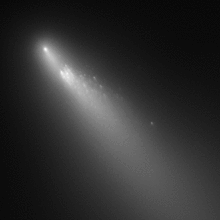 Material coming off Component B of 73P/Schwassmann–Wachmann which broke up starting in 1995, as seen by the HST. This animation covers a span of three days.
Material coming off Component B of 73P/Schwassmann–Wachmann which broke up starting in 1995, as seen by the HST. This animation covers a span of three days.
Volatiles exhausted
Jupiter-family comets (JFC) and long-period comets (LPC) (see "Orbital characteristics", above) appear to follow very different fading laws. The JFCs are active over a lifetime of about 10,000 years or ~1,000 revolutions while the LPCs disappear much faster. Only 10% of the LPCs survive more than 50 passages to small perihelion, while only 1% of them survive more than 2,000 passages.[43] Eventually most of the volatile material contained in a comet nucleus evaporates away, and the comet becomes a small, dark, inert lump of rock or rubble that can resemble an asteroid.[44]
Breakup/disintegration
Comets are also known to break up into fragments, as happened with Comet 73P/Schwassmann–Wachmann 3 starting in 1995.[45]
This breakup may be triggered by tidal gravitational forces from the Sun or a large planet, by an "explosion" of volatile material, or for other reasons not fully explained.
Collisions
Some comets meet a more spectacular end—either falling into the Sun,[46] or smashing into a planet or other body. Collisions between comets and planets or moons were common in the early Solar System: some of the many craters on the Earth's Moon, for example, may have been caused by comets. A recent collision of a comet with a planet occurred in July 1994 when Comet Shoemaker–Levy 9 broke up into pieces and collided with Jupiter.
Many comets and asteroids collided into Earth in its early stages. Many scientists believe that comets bombarding the young Earth (about 4 billion years ago) brought the vast quantities of water that now fill the Earth's oceans, or at least a significant portion of it. Other researchers have cast doubt on this theory.[47] The detection of organic molecules in comets has led some to speculate that comets or meteorites may have brought the precursors of life—or even life itself—to Earth.[13] There are still many near-Earth comets, although a collision with an asteroid is more likely than with a comet.
It is suspected that comet impacts have, over long timescales, also delivered significant quantities of water to the Earth's Moon, some of which may have survived as lunar ice.
Comet and meteoroid impacts are believed to be responsible for the existence of tektites and australites.
Nomenclature
The names given to comets have followed several different conventions over the past two centuries. Before any systematic naming convention was adopted, comets were named in a variety of ways. Prior to the early 20th century, most comets were simply referred to by the year in which they appeared, sometimes with additional adjectives for particularly bright comets; thus, the "Great Comet of 1680" (Kirch's Comet), the "Great September Comet of 1882", and the "Daylight Comet of 1910" ("Great January Comet of 1910").
After Edmund Halley demonstrated that the comets of 1531, 1607, and 1682 were the same body and successfully predicted its return in 1759, that comet became known as Halley's Comet.[48] Similarly, the second and third known periodic comets, Encke's Comet[49] and Biela's Comet,[50] were named after the astronomers who calculated their orbits rather than their original discoverers. Later, periodic comets were usually named after their discoverers, but comets that had appeared only once continued to be referred to by the year of their apparition.
In the early 20th century, the convention of naming comets after their discoverers became common, and this remains so today. A comet is named after up to three independent discoverers. In recent years, many comets have been discovered by instruments operated by large teams of astronomers, and in this case, comets may be named for the instrument. For example, Comet IRAS–Araki–Alcock was discovered independently by the IRAS satellite and amateur astronomers Genichi Araki and George Alcock. In the past, when multiple comets were discovered by the same individual, group of individuals, or team, the comets' names were distinguished by adding a numeral to the discoverers' names (but only for periodic comets); thus Comets Shoemaker–Levy 1 – 9. Today, the large numbers of comets discovered by some instruments has caused this system to be impractical, and no attempt is made to ensure that each comet is given a unique name. Instead, the comets' systematic designations are used to avoid confusion.
Until 1994, comets were first given a provisional designation consisting of the year of their discovery followed by a lowercase letter indicating its order of discovery in that year (for example, Comet 1969i (Bennett) was the 9th comet discovered in 1969). Once the comet had been observed through perihelion and its orbit had been established, the comet was given a permanent designation of the year of its perihelion, followed by a Roman numeral indicating its order of perihelion passage in that year, so that Comet 1969i became Comet 1970 II (it was the second comet to pass perihelion in 1970)[51]
Increasing numbers of comet discoveries made this procedure awkward, and in 1994 the International Astronomical Union approved a new naming system. Comets are now designated by the year of their discovery followed by a letter indicating the half-month of the discovery and a number indicating the order of discovery (a system similar to that already used for asteroids), so that the fourth comet discovered in the second half of February 2006, for example, would be designated 2006 D4. Prefixes are also added to indicate the nature of the comet:
- P/ indicates a periodic comet (defined for these purposes as any comet with an orbital period of less than 200 years or confirmed observations at more than one perihelion passage);[52]
- C/ indicates a non-periodic comet (defined as any comet that is not periodic according to the preceding definition);
- X/ indicates a comet for which no reliable orbit could be calculated (generally, historical comets);
- D/ indicates a periodic comet which has disappeared, broken up or been lost;[52]
- A/ indicates an object that was mistakenly identified as a comet, but is actually a minor planet.
For example, Comet Hale–Bopp's designation is C/1995 O1. After their second observed perihelion passage, periodic comets are also assigned a number indicating the order of their discovery.[53] So Halley's Comet, the first comet to be identified as periodic, has the systematic designation 1P/1682 Q1. Comets which first received a minor planet designation keep the latter, which leads to some odd names such as 2060 Chiron (95P/Chiron), 4015 Wilson–Harrington (107P/Wilson–Harrington), 7968 Elst–Pizarro (133P/Elst–Pizarro), 60558 Echeclus (174P/Echeclus), and 118401 LINEAR (176P/LINEAR).
History of study
Early observations and thought
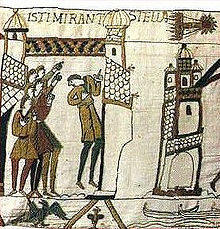 Halley's Comet depicted on the Bayeux Tapestry which shows King Harold II being told of Halley's Comet before the Battle of Hastings in 1066.
Halley's Comet depicted on the Bayeux Tapestry which shows King Harold II being told of Halley's Comet before the Battle of Hastings in 1066.
Before the invention of the telescope, comets seemed to appear out of nowhere in the sky and gradually vanish out of sight. They were usually considered bad omens of deaths of kings or noble men, or coming catastrophes, or even interpreted as attacks by heavenly beings against terrestrial inhabitants.[54] From ancient sources, such as Chinese oracle bones, it is known that their appearances have been noticed by humans for millennia. Some authorities interpret references to "falling stars" in Gilgamesh, the Book of Revelation, and the Book of Enoch as references to comets, or possibly bolides. One very famous old recording of a comet is the appearance of Halley's Comet on the Bayeux Tapestry, which records the Norman conquest of England in AD 1066.[55]
In the first book of his Meteorology, Aristotle propounded the view of comets that would hold sway in Western thought for nearly two thousand years. He rejected the ideas of several earlier philosophers that comets were planets, or at least a phenomenon related to the planets, on the grounds that while the planets confined their motion to the circle of the Zodiac, comets could appear in any part of the sky.[56] Instead, he described comets as a phenomenon of the upper atmosphere, where hot, dry exhalations gathered and occasionally burst into flame. Aristotle held this mechanism responsible for not only comets, but also meteors, the aurora borealis, and even the Milky Way.[57]
A few later classical philosophers did dispute this view of comets. Seneca the Younger, in his Natural Questions, observed that comets moved regularly through the sky and were undisturbed by the wind, behavior more typical of celestial than atmospheric phenomena. While he conceded that the other planets do not appear outside the Zodiac, he saw no reason that a planet-like object could not move through any part of the sky, humanity's knowledge of celestial things being very limited.[58] However, the Aristotelian viewpoint proved more influential, and it was not until the 16th century that it was demonstrated that comets must exist outside the Earth's atmosphere.
In 1577, a bright comet was visible for several months. The Danish astronomer Tycho Brahe used measurements of the comet's position taken by himself and other, geographically separated, observers to determine that the comet had no measurable parallax. Within the precision of the measurements, this implied the comet must be at least four times more distant from the earth than the moon.[59]
Orbital studies
Although comets had now been demonstrated to be in the heavens, the question of how they moved through the heavens would be debated for most of the next century. Even after Johannes Kepler had determined in 1609 that the planets moved about the sun in elliptical orbits, he was reluctant to believe that the laws that governed the motions of the planets should also influence the motion of other bodies—he believed that comets travel among the planets along straight lines. Galileo Galilei, although a staunch Copernicanist, rejected Tycho's parallax measurements and held to the Aristotelian notion of comets moving on straight lines through the upper atmosphere.[citation needed]
The first suggestion that Kepler's laws of planetary motion should also apply to the comets was made by William Lower in 1610.[59] In the following decades other astronomers, including Pierre Petit, Giovanni Borelli, Adrien Auzout, Robert Hooke, Johann Baptist Cysat, and Giovanni Domenico Cassini all argued for comets curving about the sun on elliptical or parabolic paths, while others, such as Christian Huygens and Johannes Hevelius, supported comets' linear motion.[citation needed]
The matter was resolved by the bright comet that was discovered by Gottfried Kirch on November 14, 1680. Astronomers throughout Europe tracked its position for several months. In 1681, the Saxon pastor Georg Samuel Doerfel set forth his proofs that comets are heavenly bodies moving in parabolas of which the sun is the focus. Then Isaac Newton, in his Principia Mathematica of 1687, proved that an object moving under the influence of his inverse square law of universal gravitation must trace out an orbit shaped like one of the conic sections, and he demonstrated how to fit a comet's path through the sky to a parabolic orbit, using the comet of 1680 as an example.[60]
In 1705, Edmond Halley applied Newton's method to twenty-three cometary apparitions that had occurred between 1337 and 1698. He noted that three of these, the comets of 1531, 1607, and 1682, had very similar orbital elements, and he was further able to account for the slight differences in their orbits in terms of gravitational perturbation by Jupiter and Saturn. Confident that these three apparitions had been three appearances of the same comet, he predicted that it would appear again in 1758–9.[61] (Earlier, Robert Hooke had identified the comet of 1664 with that of 1618,[62] while Giovanni Domenico Cassini had suspected the identity of the comets of 1577, 1665, and 1680.[63] Both were incorrect.) Halley's predicted return date was later refined by a team of three French mathematicians: Alexis Clairaut, Joseph Lalande, and Nicole-Reine Lepaute, who predicted the date of the comet's 1759 perihelion to within one month's accuracy.[64] When the comet returned as predicted, it became known as Halley's Comet (with the latter-day designation of 1P/Halley). Its next appearance will be in 2061. See the book 2061: Odyssey Three by Sir Arthur C. Clarke.
Among the comets with short enough periods to have been observed several times in the historical record, Halley's Comet is unique in that it is consistently bright enough to be visible to the naked eye while passing through the inner Solar System. Since the confirmation of the periodicity of Halley's Comet, quite a few other periodic comets have been discovered through the use of the telescope. The second comet found to have a periodic orbit was Encke's Comet (with the official designation of 2P/Encke). During the period 1819–21 the German mathematician and physicist Johann Franz Encke computed the orbits for a series of comets that had been observed in 1786, 1795, 1805, and 1818, and he concluded that they were same comet, and successfully predicted its return in 1822.[49] By 1900, seventeen comets had been observed through more than one passage through their perihelions, and then recognized as being periodic comets. As of April 2006, 175 comets have achieved this distinction, though several of these seem to have been destroyed or lost.
Studies of physical characteristics
Isaac Newton described comets as compact and durable solid bodies moving in oblique orbits, and their tails as thin streams of vapor emitted by their nuclei, ignited or heated by the sun. Newton suspected that comets were the origin of the life-supporting component of air. Newton also believed that the vapors given off by comets might replenish the planets' supplies of water (which was gradually being converted into soil by the growth and decay of plants), and the sun's supply of fuel.[citation needed]
From his huge vapouring train perhaps to shake
Reviving moisture on the numerous orbs,
Thro' which his long ellipsis winds; perhaps
To lend new fuel to declining suns,
To light up worlds, and feed th' ethereal fire."As early as the 18th century, some scientists had made correct hypotheses as to comets' physical composition. In 1755, Immanuel Kant hypothesized that comets are composed of some volatile substance, whose vaporization gives rise to their brilliant displays near perihelion.[65] In 1836, the German mathematician Friedrich Wilhelm Bessel, after observing streams of vapor during the appearance of Halley's Comet in 1835, proposed that the jet forces of evaporating material could be great enough to significantly alter a comet's orbit, and he argued that the non-gravitational movements of Encke's Comet resulted from this phenomenon.[66]
However, another comet-related discovery overshadowed these ideas for nearly a century. Over the period 1864–1866 the Italian astronomer Giovanni Schiaparelli computed the orbit of the Perseid meteors, and based on orbital similarities, correctly hypothesized that the Perseids were fragments of Comet Swift–Tuttle. The link between comets and meteor showers was dramatically underscored when in 1872, a major meteor shower occurred from the orbit of Comet Biela, which had been observed to split into two pieces during its 1846 apparition, and was never seen again after 1852.[50] A "gravel bank" model of comet structure arose, according to which comets consist of loose piles of small rocky objects, coated with an icy layer.
By the middle of the twentieth century, this model suffered from a number of shortcomings: in particular, it failed to explain how a body that contained only a little ice could continue to put on a brilliant display of evaporating vapor after several perihelion passages. In 1950, Fred Lawrence Whipple proposed that rather than being rocky objects containing some ice, comets were icy objects containing some dust and rock.[67] This "dirty snowball" model soon became accepted and appeared to be supported by the observations of an armada of spacecraft (including the European Space Agency's Giotto probe and the Soviet Union's Vega 1 and Vega 2) that flew through the coma of Halley's Comet in 1986, photographed the nucleus, and observed jets of evaporating material.
Recent findings
Debate continues about how much ice is in a comet. In 2001, NASA's Deep Space 1 team, working at NASA's Jet Propulsion Lab, obtained high-resolution images of the surface of Comet Borrelly. They announced that comet Borrelly exhibits distinct jets, yet has a hot, dry surface. The assumption that comets contain water and other ices led Dr. Laurence Soderblom of the U.S. Geological Survey to say, "The spectrum suggests that the surface is hot and dry. It is surprising that we saw no traces of water ice." However, he goes on to suggest that the ice is probably hidden below the crust as "either the surface has been dried out by solar heating and maturation or perhaps the very dark soot-like material that covers Borrelly's surface masks any trace of surface ice".[68]
In July 2005, the Deep Impact probe blasted a crater on Comet Tempel 1 to study its interior. The mission yielded results suggesting that the majority of a comet's water ice is below the surface, and that these reservoirs feed the jets of vaporised water that form the coma of Tempel 1.[69] Renamed EPOXI, it made a flyby of Comet Hartley 2 on 4 November 2010.
The Stardust spacecraft, launched in February 1999, collected particles from the coma of Comet Wild 2 in January 2004, and returned the samples to Earth in a capsule in January 2006. Claudia Alexander, a program scientist for Rosetta from NASA's Jet Propulsion Laboratory who has modeled comets for years, reported to space.com about her astonishment at the number of jets, their appearance on the dark side of the comet as well as on the light side, their ability to lift large chunks of rock from the surface of the comet and the fact that comet Wild 2 is not a loosely cemented rubble pile.[70]
More recent data from the Stardust mission show that materials retrieved from the tail of Wild 2 were crystalline and could only have been "born in fire."[71][72] Although comets formed in the outer Solar System, radial mixing of material during the early formation of the Solar System is thought to have redistributed material throughout the proto-planetary disk,[73] so comets also contain crystalline grains which were formed in the hot inner Solar System. This is seen in comet spectra as well as in sample return missions. More recent still, the materials retrieved demonstrate that the "comet dust resembles asteroid materials."[74] These new results have forced scientists to rethink the nature of comets and their distinction from asteroids.[75]
In April 2011, scientists from the University of Arizona discovered evidence for the presence of liquid water in a Comet Wild 2. They have found iron and copper sulfide minerals that must have formed in the presence of water. The discovery shatters the existing paradigm that comets never get warm enough to melt their icy bulk.[76]
Forthcoming space missions will add greater detail to our understanding of what comets are made of. The European Rosetta probe is presently en route to Comet Churyumov–Gerasimenko; in 2014 it will go into orbit around the comet and place a small lander on its surface.
Spacecraft targets
The following table lists comets that have been visited by spacecraft.
Name Discovered Spacecraft Year(s) Closest
Approach
(km)Notes Borrelly December 28, 1904 Deep Space 1 2001 ? Flyby Tempel 1 April 3, 1867 Deep Impact 2005 ? Flyby; Blasted a crater using an impactor Hartley 2 March 15, 1986 EPOXI,
(was Deep Impact)2010 700 Flyby; smallest comet visited Wild 2 January 6, 1978 Stardust 2004 240 Flyby: Returned samples to Earth Tempel 1 April 3, 1867 Stardust 2011 181 Flyby; Imaged the crater created by Deep Impact Churyumov–Gerasimenko September 11, 1969 Rosetta 2014 ? Planned to orbit Notable comets
Great comets
While hundreds of tiny comets pass through the inner Solar System every year, very few are noticed by the general public. About every decade or so, a comet will become bright enough to be noticed by a casual observer—such comets are often designated Great Comets. In times past, bright comets often inspired panic and hysteria in the general population, being thought of as bad omens. More recently, during the passage of Halley's Comet in 1910, the Earth passed through the comet's tail, and erroneous newspaper reports inspired a fear that cyanogen in the tail might poison millions,[77] while the appearance of Comet Hale–Bopp in 1997 triggered the mass suicide of the Heaven's Gate cult. To most people, however, a great comet is simply a beautiful spectacle.
Predicting whether a comet will become a great comet is notoriously difficult, as many factors may cause a comet's brightness to depart drastically from predictions. Broadly speaking, if a comet has a large and active nucleus, will pass close to the Sun, and is not obscured by the Sun as seen from the Earth when at its brightest, it will have a chance of becoming a great comet. However, Comet Kohoutek in 1973 fulfilled all the criteria and was expected to become spectacular, but failed to do so. Comet West, which appeared three years later, had much lower expectations (perhaps because scientists were much warier of glowing predictions after the Kohoutek fiasco), but became an extremely impressive comet.[78]
The late 20th century saw a lengthy gap without the appearance of any great comets, followed by the arrival of two in quick succession—Comet Hyakutake in 1996, followed by Hale–Bopp, which reached maximum brightness in 1997 having been discovered two years earlier. The first great comet of the 21st century was C/2006 P1 (McNaught), which became visible to naked eye observers in January 2007. It was the brightest in over 40 years.
Sungrazing comets
A Sungrazing comet is a comet that passes extremely close to the Sun at perihelion, sometimes within a few thousand kilometres of the Sun's surface. While small sungrazers can be completely evaporated during such a close approach to the Sun, larger sungrazers can survive many perihelion passages. However, the strong tidal forces they experience often lead to their fragmentation.
About 90% of the sungrazers observed with SOHO are members of the Kreutz group, which all originate from one giant comet that broke up into many smaller comets during its first passage through the inner Solar System.[79] The other 10% contains some sporadic sungrazers, but four other related groups of comets have been identified among them: the Kracht, Kracht 2a, Marsden and Meyer groups. The Marsden and Kracht groups both appear to be related to Comet 96P/Machholz, which is also the parent of two meteor streams, the Quadrantids and the Arietids.[80]
Unusual comets
Of the thousands of known comets, some are very unusual. Encke's Comet orbits from outside the asteroid belt to just inside the orbit of the planet Mercury while the Comet 29P/Schwassmann–Wachmann currently travels in a nearly circular orbit entirely between the orbits of Jupiter and Saturn.[81] 2060 Chiron, whose unstable orbit is between Saturn and Uranus, was originally classified as an asteroid until a faint coma was noticed.[82] Similarly, Comet Shoemaker–Levy 2 was originally designated asteroid near-earth asteroids are thought to be extinct nuclei of comets which no longer experience outgassing.[43]
Some comets have been observed to break up during their perihelion passage, including great comets West and Ikeya–Seki. Biela's Comet was one significant example, when it broke into two pieces during its passage through the perihelion in 1846. These two comets were seen separately in 1852, but never again afterward. Instead, spectacular meteor showers were seen in 1872 and 1885 when the comet should have been visible. A lesser meteor shower, the Andromedids, occurs annually in November, and it is caused when the Earth crosses the orbit of Biela's Comet.[84]
Another significant cometary disruption was that of Comet Shoemaker–Levy 9, which was discovered in 1993. At the time of its discovery, the comet was in orbit around Jupiter, having been captured by the planet during a very close approach in 1992.[85] This close approach had already broken the comet into hundreds of pieces, and over a period of six days in July 1994, these pieces slammed into Jupiter's atmosphere—the first time astronomers had observed a collision between two objects in the Solar System.[86] It has also been suggested that the object likely to have been responsible for the Tunguska event in 1908 was a fragment of Encke's Comet.[87]
Observation
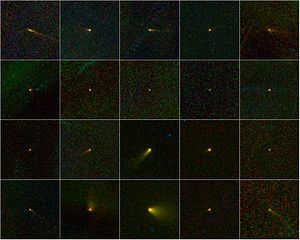 A sampling of 20 newly discovered comets from WISE observations during 2010 and 2011. (infrared images)
A sampling of 20 newly discovered comets from WISE observations during 2010 and 2011. (infrared images)
A new comet may be discovered photographically using a wide-field telescope or visually with binoculars. However, even without access to optical equipment, it is still possible for the amateur astronomer to discover a Sun-grazing comet online by downloading images accumulated by some satellite observatories such as SOHO.[88] SOHO's 2000th comet was discovered by Polish amateur astronomer Michał Kusiak on 26 December 2010,[89] and the numbers are expected to continue rising steadily for the foreseeable future.
Comets visible to the naked eye are fairly infrequent, but comets that put on fine displays in amateur class telescopes (50 mm to 100 cm) occur fairly often—as often as several times a year, occasionally with more than one in the sky at the same time. Commonly available astronomical software will plot the orbits of these known comets. They are fast compared to other objects in the sky, but their movement is usually subtle in the eyepiece of a telescope. However, from night to night, they can move several degrees, which is why observers find it useful to have a sky chart such as the one in the adjoining illustration.
The type of display presented by the comet depends on its composition and how close it comes to the sun. Because the volatility of a comet's material decreases as it gets further from the sun, the comet becomes increasingly difficult to observe as a function of not only distance, but the progressive shrinking and eventual disappearance of its tail and the reflective elements it carries. Comets are most interesting when their nucleus is bright and they display a long tail, which to be seen sometimes requires a large field of view best provided by smaller telescopes. Therefore, large amateur instruments (apertures of 25 cm (10 in) or larger) that have fainter light grasp do not necessarily confer an advantage in terms of viewing comets. The opportunity to view spectacular comets with relatively small aperture instruments in the 8 cm (3 in) to 15 cm (6 in) range is more frequent than might be guessed from the relatively rare attention they get in the mainstream press.
In popular culture
The depiction of comets in popular culture is firmly rooted in the long Western tradition of seeing comets as harbingers of doom and as omens of world-altering change.[90] Halley's Comet alone has caused a slew of frightful or excited publications of all sorts at each of its reappearances. It was especially noted that the birth and death of some notable persons coincided with separate appearances of the comet, such as with writers Mark Twain (who correctly speculated that he'd "go out with the comet" in 1910)[90] and Eudora Welty, to whose life Mary Chapin Carpenter dedicated the song Halley Came to Jackson.[90]
In science fiction, the impact of comets has been depicted as a threat overcome by technology and heroism (Deep Impact, 1998), or as a trigger of global apocalypse (Lucifer's Hammer, 1979) or of waves of zombies (Night of the Comet, 1984).[90] Near impacts have been depicted in Jules Verne's Off on a Comet and Tove Jansson's Comet in Moominland, while a large manned space expedition visits Halley's Comet in Sir Arthur C. Clarke's novel 2061: Odyssey Three.
See also
References
- ^ a b Davidsson, B. (2008). "Comets – Relics from the birth of the Solar System". Uppsala University. http://www.astro.uu.se/~bjorn/eng_comet.html. Retrieved 2009-04-25.
- ^ "What is the difference between asteroids and comets?". Rosetta FAQ. European Space Agency. http://www.esa.int/esaMI/Rosetta/SEMHBK2PGQD_0.html. Retrieved 2009-04-25.
- ^ "What Are Asteroids And Comets?". Near Earth Object Program FAQ. NASA. http://neo.jpl.nasa.gov/faq/#ast. Retrieved 2009-04-25.
- ^ Shiga, D. (24 January 2008). "Comet samples are surprisingly asteroid-like". New Scientist. http://space.newscientist.com/channel/solar-system/comets-asteroids/dn13224-comet-samples-are-surprisingly-asteroidlike.html. Retrieved 2009-04-25.
- ^ Johnston, R. (22 January 2011). "Known populations of solar system objects". http://www.johnstonsarchive.net/astro/sslist.html. Retrieved 2011-03-09.
- ^ "JPL comet orbital elements". Jet Propulsion Lab. http://ssd.jpl.nasa.gov/dat/ELEMENTS.COMET. Retrieved 2008-12-27.
- ^ "How Many Comets Are There?". Rosetta FAQ. European Space Agency. 9 November 2007. http://www.esa.int/SPECIALS/Rosetta/SEMSCM474OD_0.html. Retrieved 2009-12-16.
- ^ Licht, A. L. (1999). "The Rate of Naked-Eye Comets from 101 BC to 1970 AD". Icarus 137 (2): 355. Bibcode 1999Icar..137..355L. doi:10.1006/icar.1998.6048.
- ^ κομήτης, Henry George Liddell, Robert Scott, A Greek–English Lexicon, on Perseus
- ^ κόμη, Henry George Liddell, Robert Scott, A Greek–English Lexicon, on Perseus
- ^ a b Yeomans, Donald K. (2005). "Comet". World Book Online Reference Center. World Book. http://www.nasa.gov/worldbook/comet_worldbook.html. Retrieved 2008-12-27.
- ^ Meech, M. (14 February 1997). "1997 Apparition of Comet Hale–Bopp: What We Can Learn from Bright Comets". Planetary Science Research Discoveries. http://www.psrd.hawaii.edu/Feb97/Bright.html. Retrieved 2009-04-25.
- ^ a b Stenger, R. (6 April 2001). "Test boosts notion that comets brought life". CNN. http://archives.cnn.com/2001/TECH/space/04/06/comet.life/. Retrieved 2009-04-25.
- ^ "Stardust Findings Suggest Comets More Complex Than Thought". NASA. 14 December 2006. http://stardust.jpl.nasa.gov/news/news110.html. Retrieved 2009-04-25.
- ^ "Found: first amino acid on a comet", New Scientist, 17 August 2009
- ^ Callahan; Smith, K.E.; Cleaves, H.J.; Ruzica, J.; Stern, J.C.; Glavin, D.P.; House, C.H.; Dworkin, J.P. (11 August 2011). "Carbonaceous meteorites contain a wide range of extraterrestrial nucleobases". PNAS. doi:10.1073/pnas.1106493108. http://www.pnas.org/content/early/2011/08/10/1106493108. Retrieved 2011-08-15.
- ^ Steigerwald, John (8 August 2011). "NASA Researchers: DNA Building Blocks Can Be Made in Space". NASA. http://www.nasa.gov/topics/solarsystem/features/dna-meteorites.html. Retrieved 2011-08-10.
- ^ ScienceDaily Staff (9 August 2011). "DNA Building Blocks Can Be Made in Space, NASA Evidence Suggests". ScienceDaily. http://www.sciencedaily.com/releases/2011/08/110808220659.htm. Retrieved 2011-08-09.
- ^ a b Britt, R. R. (29 November 2001). "Comet Borrelly Puzzle: Darkest Object in the Solar System". Space.com. http://www.space.com/scienceastronomy/solarsystem/borrelly_dark_011129.html. Retrieved 2008-10-26.
- ^ Cochran, A. L.; Levison, H. F.; Stern, S. A.; Duncan, J. (1995). "The Discovery of Halley-sized Kuiper Belt Objects Using the Hubble Space Telescope". Astrophysical Journal 455: 342. arXiv:astro-ph/9509100. Bibcode 1995ApJ...455..342C. doi:10.1086/176581.
- ^ Cochran, A. L.; Levison, H. F.; Tamblyn, P.; Stern, S. A.; Duncan, J. (1998). "The Calibration of the Hubble Space Telescope Kuiper Belt Object Search: Setting the Record Straight". Astrophysical Journal Letters 503 (1): L89. arXiv:astro-ph/9806210. Bibcode 1998ApJ...503L..89C. doi:10.1086/311515.
- ^ Brown, Michael E.; Kulkarni, S. R.; Liggett, T. J. (1997). "An Analysis of the Statistics of the Hubble Space Telescope Kuiper Belt Object Search". Astrophysical Journal Letters 490 (1): L119. Bibcode 1997ApJ...490L.119B. doi:10.1086/311009.
- ^ Jewitt, David C.; Luu, Jane; Chen, J. (1996). "The Mauna Kea – Cerro-Tololo (MKCT) Kuiper Belt and Centaur Survey". Astronomical Journal 112 (3): 1225. Bibcode 1996AJ....112.1225J. doi:10.1086/118093.
- ^ Jewitt, David (2007-11-09). "Comet Holmes Bigger Than The Sun". Institute for Astronomy at the University of Hawaii. http://www2.ess.ucla.edu/~jewitt/holmes.html. Retrieved 2007-11-17.
- ^ McKenna, M. (20 May 2008). "Chasing an Anti-Tail". Astronomy Sketch of the Day. http://www.asod.info/?p=1019. Retrieved 2009-02-25.
- ^ Biermann, L. (1963). "The plasma tails of comets and the interplanetary plasma". Space Science Reviews 1 (3): 553. Bibcode 1963SSRv....1..553B. doi:10.1007/BF00225271.
- ^ a b Carroll, B. W.; Ostlie, D. A. (1996). An Introduction to Modern Astrophysics. Addison-Wesley. pp. 864–874. ISBN 0201547309.
- ^ Eyles, C. J.; Harrison, R. A.; Davis, C. J.; Waltham, N. R.; Shaughnessy, B. M.; Mapson-Menard, H. C. A.; Bewsher, D.; Crothers, S. R. et al. (2009). "The Heliospheric Imagers Onboard the STEREO Mission". Solar Physics 254 (2): 387–445. Bibcode 2009SoPh..254..387E. doi:10.1007/s11207-008-9299-0.
- ^ Lisse, C. M.; K. Dennerl, J. Englhauser, M. Harden, F. E. Marshall, M. J. Mumma, R. Petre, J. P. Pye, M. J. Ricketts, J. Schmitt, J. Trümper, and R. G. West (1996). "Discovery of X-ray and Extreme Ultraviolet Emission from Comet C/Hyakutake 1996 B2". Science 274 (5278): 205–209. Bibcode 1996Sci...274..205L. doi:10.1126/science.274.5285.205. http://www.sciencemag.org/content/274/5285/205.short.
- ^ Lisse, C. M.; D. J. Christian, K. Dennerl, K. J. Meech, R. Petre, H. A. Weaver and S. J. Wolk (2001). "Charge Exchange-Induced X-Ray Emission from Comet C/1999 S4 (LINEAR)". Science 292 (5520): 1343–1348. Bibcode 2001Sci...292.1343L. doi:10.1126/science.292.5520.1343. http://www.sciencemag.org/content/292/5520/1343.abstract.
- ^ a b "Major Meteor Showers". Meteor Showers Online. http://meteorshowersonline.com/major_meteor_showers.html. Retrieved 2009-05-18.
- ^ a b c "Small Bodies: Profile". NASA/JPL. 29 October 2008. http://pds.jpl.nasa.gov/planets/special/smbod.htm. Retrieved 2009-04-26.
- ^ Elenin, Leonid (7 March 2011). "Influence of giant planets on the orbit of comet C/2010 X1". http://spaceobs.org/en/2011/03/07/vliyanie-planet-gigantov-na-orbitu-komety-c2010-x1-elenin/.
- ^ Chebotarev, G.A. (1964). "Gravitational Spheres of the Major Planets, Moon and Sun". Soviet Astronomy 7 (5): 618–622. Bibcode 1964SvA.....7..618C.
- ^ a b Use the JPL Small-Body Database Search Engine. Under "Limit by object characteristics", select the 2nd pulldown with "e>1" (Add). Under "Pre-defined field sets:" select "asteroid – basic" (Append Selected). Click "Generate Table".
- ^ "JPL Small-Body Database Browser: C/1980 E1 (Bowell)". 1986-12-02 last obs. http://ssd.jpl.nasa.gov/sbdb.cgi?sstr=1980E1. Retrieved 2010-03-22.
- ^ "Comet". Encyclopædia Britannica Online. http://www.britannica.com/eb/article-54344/comet. Retrieved 2009-04-26.
- ^ IAU bulletin IB74
- ^ Reddy, F. (3 April 2006). "New comet class in Earth's backyard". Astronomy. http://www.astronomy.com/asy/default.aspx?c=a&id=4100. Retrieved 2009-04-29.
- ^ Oort, Jan H. (1950). "The structure of the cloud of comets surrounding the Solar System and a hypothesis concerning its origin". Bulletin of the Astronomical Institutes of the Netherlands (NASA Astrophysics Data System) XI (408): 91–110. Bibcode 1950BAN....11...91O.
- ^ McGlynn, Thomas A.; Chapman, Robert D. (1989). "On the nondetection of extrasolar comets". Astrophysical Journal Letters 346: L105–L108. Bibcode 1989ApJ...346L.105M. doi:10.1086/185590.
- ^ Kronk, Gary W.. "11P/Tempel–Swift–LINEAR". Gary W. Kronk's Cometography. http://cometography.com/pcomets/011p.html. Retrieved 2009-04-27.
- ^ a b Whitman, K.; Morbidelli, Alessandro; Jedicke, Robert (2006). "The Size–Frequency Distribution of Dormant Jupiter Family Comets". Icarus 183: 101. arXiv:astro-ph/0603106v2. Bibcode 2006Icar..183..101W. doi:10.1016/j.icarus.2006.02.016.
- ^ Lyzenga, G. (16 November 1998). "If comets melt, why do they seem to last for long periods of time?". Scientific American. http://www.sciam.com/article.cfm?id=if-comets-melt-why-do-the. Retrieved 2009-04-26.
- ^ Clavin, W. (10 May 2006). "Spitzer Telescope Sees Trail of Comet Crumbs". Spitzer Science Center. http://www.spitzer.caltech.edu/Media/releases/ssc2006-13/release.shtml. Retrieved 2008-10-25.[dead link]
- ^ "SOHO analyes a kamikaze comet". European Space Agency. 23 February 2001. http://www.esa.int/esaCP/ESA26YTM5JC_FeatureWeek_0.html. Retrieved 2009-04-26.
- ^ Muir, H. (25 September 2007). "Earth's water brewed at home, not in space". New Scientist. http://space.newscientist.com/article/dn12693-earths-water-brewed-at-home-not-in-space.html. Retrieved 2009-04-26.
- ^ Ridpath, Ian (3 July 2008). "Halley and his Comet". A brief history of Halley's Comet. http://www.ianridpath.com/halley/halley4.htm. Retrieved 2009-04-27.
- ^ a b Kronk, Gary W.. "2P/Encke". Gary W. Kronk's Cometography. http://cometography.com/pcomets/002p.html. Retrieved 2009-04-27.
- ^ a b Kronk, Gary W.. "3D/Biela". Gary W. Kronk's Cometography. http://cometography.com/pcomets/003d.html. Retrieved 2009-04-27.
- ^ Arnett, B. (14 January 2000). " 'Official' Astronomical Names". International Astronomical Union. http://www.nineplanets.org/names.html. Retrieved 2006-03-05.
- ^ a b "Cometary Designation System". Minor Planet Center. http://www.minorplanetcenter.net/iau/lists/CometResolution.html. Retrieved 2011-07-03.
- ^ "Cometary Designation System". Committee on Small Body Nomenclature. 1994. http://www.minorplanetcenter.org/iau/lists/CometResolution.html. Retrieved 2010-08-24.
- ^ Ridpath, Ian (8 July 2008). "Comet lore". A brief history of Halley's Comet. http://www.ianridpath.com/halley/halley1.htm. Retrieved 2009-04-27.
- ^ "Long Live the King – Scene 1". Bayeux tapestry. Museum of Reading. http://www.bayeuxtapestry.org.uk/Bayeux14.htm. Retrieved 2009-04-17.
- ^ Aristotle (350 BCE). "Book I, part 6". Meteorologica. Webster, E. W. (trans.). ISBN 0824096010. http://classics.mit.edu/Aristotle/meteorology.1.i.html.
- ^ Aristotle (350 BCE). "Book I, part 7". Meteorologica. Webster, E. W. (trans.). ISBN 0824096010. http://classics.mit.edu/Aristotle/meteorology.1.i.html.
- ^ Sagan, Carl; Druyan, Ann (1985). Comet. Random House. pp. 23–24. ISBN 0-394-54908-2.
- ^ a b "A Brief History of Comets I (until 1950)". European Southern Observatory. 17 October 2003. http://www.eso.org/public/events/astro-evt/hale-bopp/comet-history-1.html. Retrieved 2009-04-27.
- ^ Newton, Isaac (1687). "Lib. 3, Prop. 41". Philosophiæ Naturalis Principia Mathematica. Royal Society of London. ISBN 0521076471.
- ^ Halleio, Edmundo (1705). "Astronomiæ Cometicæ Synopsis". Philosophical Transactions 24 (289–304): 1882–1899. doi:10.1098/rstl.1704.0064.
- ^ Pepys, Samuel (1665). "March 1st". Diary of Samuel Pepys. ISBN 0520221672. http://en.wikisource.org/wiki/Diary_of_Samuel_Pepys/1665/March#March_1st.
- ^ Sagan, Carl; Druyan, Ann (1985). Comet. Random House. pp. 42–43. ISBN 0-394-54908-2.
- ^ Sagan, Carl; Druyan, Ann (1985). Comet. Random House. p. 83. ISBN 0-394-54908-2.
- ^ Sagan, Carl; Druyan, Ann (1985). Comet. Random House. p. 77. ISBN 0-394-54908-2.
- ^ Sagan, Carl; Druyan, Ann (1985). Comet. Random House. pp. 117. ISBN 0-394-54908-2.
- ^ Whipple, Fred L. (1950). "A Comet Model I. The Acceleration of Comet Encke". Astrophysical Journal 111: 375–394. Bibcode 1950ApJ...111..375W. doi:10.1086/145272.
- ^ "NASA Spacecraft Finds Comet Has Hot, Dry Surface". JPL. 5 April 2002. Archived from the original on 2006-02-07. http://web.archive.org/web/20060207164931/http://www.jpl.nasa.gov/releases/2002/release_2002_80.html. Retrieved 2006-03-05.
- ^ "NASA's 'Deep Impact' Team Reports First Evidence of Cometary Ice". Brown University. 2 February 2006. http://www.brown.edu/Administration/News_Bureau/2005-06/05-072.html. Retrieved 2007-07-27.
- ^ Britt, R. R. (17 June 2004). "Strange Comet Unlike Anything Known". Space.com. http://www.space.com/scienceastronomy/stardust_results_040617.html. Retrieved 2006-03-05.
- ^ Rincon, P. (14 March 2006). "Comets 'are born of fire and ice' ". London: BBC News. http://news.bbc.co.uk/2/hi/science/nature/4801968.stm. Retrieved 2009-04-27.
- ^ Malik, T. (13 March 2006). "NASA's Stardust Comet Samples Contain Minerals Born in Fire". Space.com. http://www.space.com/scienceastronomy/060313_stardust_update.html. Retrieved 2009-04-27.
- ^ van Boekel, R.; Min, M; M., Ch.; Leinert, L. B. F. M.; Waters, A.; Richichi, O.; Chesneau, C.; Dominik, W. et al. (2004). "The building blocks of planets within the 'terrestrial' region of protoplanetary disks". Nature 432 (7016): 479–82. Bibcode 2004Natur.432..479V. doi:10.1038/nature03088. PMID 15565147.
- ^ "Stardust comet dust resembles asteroid materials". Lawrence Livermore National Laboratory. 24 January 2008. https://publicaffairs.llnl.gov/news/news_releases/2008/NR-08-01-05.html. Retrieved 2009-04-27.
- ^ Dunham, W. (25 January 2008). "Dust samples prompt rethink about comets". Reuters. http://www.reuters.com/article/scienceNews/idUSN2537011620080126?sp=true. Retrieved 2008-12-27.
- ^ LeBlanc, Cecile (2011-04-07). "Evidence for liquid water on the surface of Comet Wild-2". http://earthsky.org/space/evidence-for-liquid-water-on-the-surface-of-comet-wild-2. Retrieved 2011-04-07.
- ^ Ridpath, Ian (3 July 2008). "Awaiting the Comet". A brief history of Halley's Comet. http://www.ianridpath.com/halley/halley11.htm. Retrieved 2008-08-11.
- ^ Kronk, Gary W.. "C/1975 V1 (West)". Gary W. Kronk's Cometography. http://cometography.com/lcomets/1975v1.html. Retrieved 2006-03-05.
- ^ Bailey, M. E.; Chambers, J. E.; Hahn, G. (1992). "Origin of sungrazers: a frequent cometary end-state". Astronomy and Astrophysics 257 (1): 315–322. Bibcode 1992A&A...257..315B.
- ^ Ohtsuka, K.; Nakano, S.; Yoshikawa, M. (2003). "On the Association among Periodic Comet 96P/Machholz, Arietids, the Marsden Comet Group, and the Kracht Comet Group". Publications of the Astronomical Society of Japan 55 (1): 321–324. Bibcode 2003PASJ...55..321O. http://pasj.asj.or.jp/v55/n1/550127/55012319.pdf.
- ^ Kronk, Gary W.. "29P/Schwassmann–Wachmann 1". Gary W. Kronk's Cometography. http://cometography.com/pcomets/029p.html. Retrieved 2009-04-27.
- ^ Kronk, Gary W.. "95P/Chiron". Gary W. Kronk's Cometography. http://cometography.com/pcomets/095p.html. Retrieved 2009-04-27.
- ^ Kronk, Gary W.. "137P/Shoemaker–Levy 2". Gary W. Kronk's Cometography. http://cometography.com/pcomets/137p.html. Retrieved 2009-04-27.
- ^ "The Andromedids". Meteor Showers Online. http://meteorshowersonline.com/showers/andromedids.html. Retrieved 2009-04-27.
- ^ Foust, J.. "Comet Shoemaker–Levy 9 – Collision with Jupiter". Students for the Exploration and Development of Space. http://seds.lpl.arizona.edu/sl9/sl9.html. Retrieved 2009-04-27.
- ^ Kronk, Gary W.. "D/1993 F2 Shoemaker–Levy 9". Gary W. Kronk's Cometography. http://cometography.com/pcomets/1993f2.html. Retrieved 2009-04-27.
- ^ Kresk, L. (1978). "The Tunguska object: a fragment of Comet Encke?". Bulletin of the Astronomical Institutes of Czechoslovakia 29 (3): 129–134. Bibcode 1978BAICz..29..129K.
- ^ Farmer, S. E. (9 August 2009). "Getting Started – SOHO Comet Hunting Techniques/Instructions". Red Barn Observatory. http://www.cometary.net/searching_for_soho_comets.htm. Retrieved 2007-07-27.
- ^ SOHO's 2000th Comet Spotted By Student, SOHO Hotshots, 28 December 2010
- ^ a b c d Van Riper, A. B. (2002). Science in popular culture: a reference guide. Greenwood Press. p. 29. ISBN 0313318220.
Further reading
- Schechner, S. J. (1997). Comets, Popular Culture, and the Birth of Modern Cosmology. Princeton University Press..
- Brandt, J.C. and Chapman, R.D.: Introduction to comets, Cambridge University Press 2004
External links
- Comets at the Open Directory Project
- Comets Page at NASA's Solar System Exploration
- International Comet Quarterly
- How to Make a Model of a Comet audio slideshow – National High Magnetic Field Laboratory
- Catalogue of the Solar System Small Bodies Orbital Evolution
Comets Features Nucleus · Coma · Tails · Antitail · Dust trail

Types Extinct · Lost · Great · Main-belt · Sungrazing (Kreutz Sungrazers) · Interstellar
Lists See also The Solar System 
Small Solar System bodies Minor planets - Designation
- Groups
- Moons
- Meanings of names
- Pronunciation of names
Comets Meteoroids Lists / categories - Asteroid groups and families
- Asteroid moons
- Binary asteroids
- Minor planets
Far flyby Near flyby Vega program (1 · 2) · Giotto · Suisei · Deep Space 1 · CONTOUR (failed) · Deep Impact/EPOXI · Stardust/NExT · RosettaSample return Lander Planned and Proposed Cancelled VESTA · CRAF · Marco PoloItalics indicate active missions.
Halley Armada Categories:- Comets
- Greek loanwords
Wikimedia Foundation. 2010.

